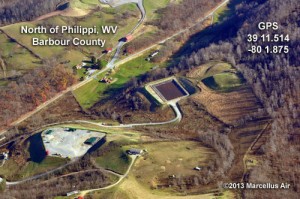Increase distance between well pads and people, environmental groups urge
From an Article by Don Hopey, Pittsburgh Post Gazette, March 2, 2016
Moms Clean Air Force and several other grassroots environmental organizations have called on the state PA-Department of Environmental Protection to better protect human health by increasing the buffer zones between shale gas wells and residences, workplaces, businesses and schools.
About 25 group members attended a news conference Wednesday outside the PA-DEP’s regional offices on Washington’s Landing, where speakers cited a new study published in the journal Environmental Health Perspectives that indicates state-required setbacks between hydraulically fractured gas wells and homes may leave residents, schoolchildren and the public vulnerable to explosions, heat, toxic gas clouds and air pollution.
The study, in the online, peer-reviewed National Institute of Environmental Health Services journal published February 19, concluded that larger setback distances and additional pollution controls on well operations are necessary to protect public health.
“Our research shows that the current setback distances between fracked gas wells and homes, schools, and health care centers are not enough to protect public health, especially children,” said Dr. Marsha Haley, a radiation oncologist at the University of Pittsburgh Cancer Institute and lead author of the study.
Patrice Tomcik, a field organizer for Moms Clean Air Force, delivered a copy of the study to PA-DEP spokesman John Poister, who attended the news conference. She said it “supports what moms living in the shale fields have known for a long time: Our children, who are a vulnerable population, are not adequately protected from the hazards of unconventional wells with the current setbacks.”
The study looked at well-residential setback distance regulations for Marcellus Shale gas wells in Pennsylvania, Barnett Shale wells in Texas and Niobrara Shale wells in Colorado, and reviewed local geography, evacuations and air pollution models.
It noted that typical air emissions from shale gas drilling and fracking operations include airborne soot, carbon monoxide, nitrogen dioxide, methane, and volatile organic compounds like toxic benzene, toluene and ethyl benzene. And it cited air sampling at dozens of locations in the three states that found emissions concentrations at and near well sites that exceeded human health standards.
It also cited more than 40 well blowouts that resulted in evacuations, road closures and in one case, a temporary no-fly zone. The required setback between a shale gas well and the nearest residence is now 500 feet in Pennsylvania, 200 feet in Texas, and 500 feet in Colorado, except in high population density areas, where it’s 1,000 feet.
“With the new leadership in Harrisburg,” Dr. Haley said, “we hope to see them adopt more generous setback distances to protect public health.”
Jane Worthington, a nurse, mother of two, and resident of Mt. Pleasant, where there are 93 active shale gas wells, said her 12-year-old daughter has developed asthma, bloody noses, gastrointestinal problems, headaches, joint swelling and rashes, and been diagnosed with low-level benzene exposure. “I worry every day that that my daughter’s health has suffered because of her proximity to the well pads,” Ms. Worthington said. “Setbacks should protect my daughter and all children.”
According to the study, existing well-residence buffer zones in a majority of cases were not based on scientific analysis of such data, but rather are the result of “a compromise between governments, the regulated community, environmental and citizen interest groups and landowners.”
“Setback distances are based on a one-size-fits-all standard, but one size fits none when it comes to setbacks protecting people,” said Michael McCawley, a study author and interim chair of the Department of Occupational and Environmental Health Services at West Virginia University.
“The regulatory setbacks don’t take into account the geologic features, the hills and valleys that can trap emissions,” Mr. McCawley said. “And the setbacks also assume that the emissions are only coming from the well pad and not the diesel emissions from thousands of truck trips during well completion work.”
In response to questions about how Pennsylvania’s setback distance was calculated, Mr. Poister issued a written statement from PA-DEP’s Oil and Gas Management Bureau in Harrisburg that said, “The setback distances were established in Section 3215(a) of the 2012 Oil and Gas Act by the General Assembly and any changes would need to be made by the legislature.”
Mr. Poister said he will forward the study to PA-DEP officials in Harrisburg.
> > > > > > > > > >
Source Reference to Original Article:
Adequacy of Current State Setbacks for Directional High-Volume Hydraulic Fracturing in the Marcellus, Barnett, and Niobrara Shale Plays
Authors are Marsha Haley (1), Michael McCawley (2), Anne C. Epstein (3), Bob Arrington (4), and Elizabeth Ferrell Bjerke (5)
(1)Department of Radiation Oncology, University of Pittsburgh Cancer Institute, Pittsburgh, Pennsylvania, USA; (2) Department of Public Health, West Virginia University, Morgantown, West Virginia, USA; (3) Department of Internal Medicine, Texas Tech University Health Sciences Center School of Medicine, Lubbock, Texas, USA: (4) Parachute, Colorado, USA; (5) Graduate School of Public Health, Department of Health Policy and Management, University of Pittsburgh School of Law, Pittsburgh, Pennsylvania, USA
http://ehp.niehs.nih.gov/wp-content/uploads/advpub/2016/2/ehp.1510547.acco.pdf

